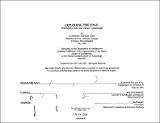Exploding the edge : inversions into the urban landscape
Author(s)
Chia, Katherine Kai-sun
DownloadFull printable version (34.19Mb)
Alternative title
Inversions into the urban landscape
Other Contributors
Massachusetts Institute of Technology. Dept. of Architecture.
Advisor
Julie Moir Messervy.
Terms of use
Metadata
Show full item recordAbstract
This thesis explores the relationship between building and green space in a dense urban environment in order to create a humane contemplative experience of individual and collective memory. The urban environment has the potential to inform a new attitude for open space which incorporates the building as a landscape element and weaves natural and architectural elements together physically and metaphorically. The building and the open space are inversions of each other while referencing the district around them, the cultural landscape. As a result, the form of the built urban context has the potential to define the urban edge along which everyday activity occurs while providing a place of refuge and protection for those who seek an occasional mental and physical retreat. The design, a small-scale public garden for Boston's Chinatown, references the urban Chinese landscape garden in order to reinforce the identity of this historic ethnic neighborhood within the downtown landscape of Boston. Two buildings - housing a tea house, restaurant, and information center- explore the zones of edge conditions between the outdoor and indoor spaces. Within the stratified realm of inhabitation, edge transitions between garden and architecture can establish new reference planes. By exploiting (and, perhaps, exploding) the edge between open space and building, the design process will treat the building as a landscape in itself as well as a landscape element in relationship to the garden.
Description
Thesis (M. Arch.)--Massachusetts Institute of Technology, Dept. of Architecture, 1991. Includes bibliographical references (p. 135-137).
Date issued
1991Department
Massachusetts Institute of Technology. Department of ArchitecturePublisher
Massachusetts Institute of Technology
Keywords
Architecture.